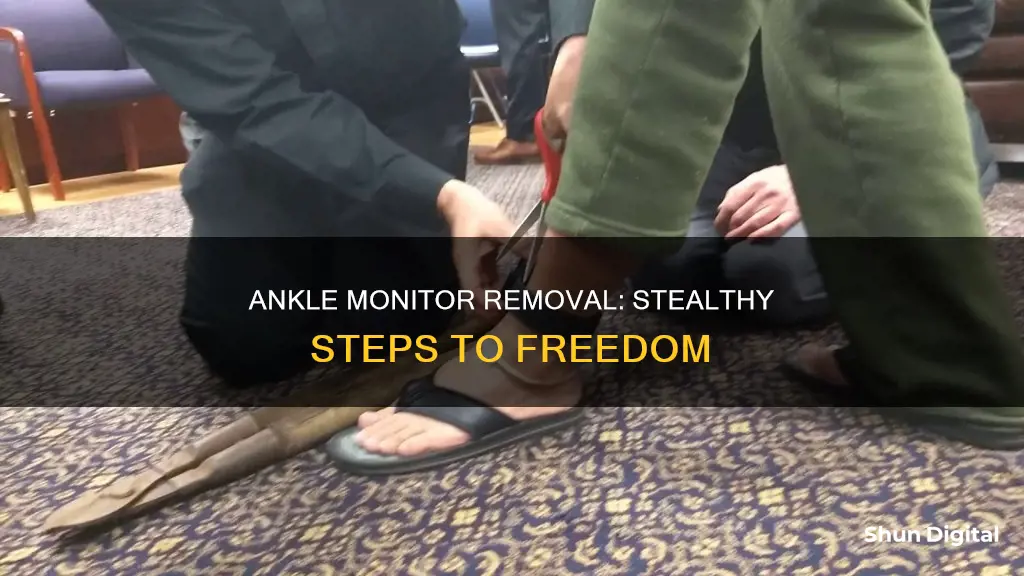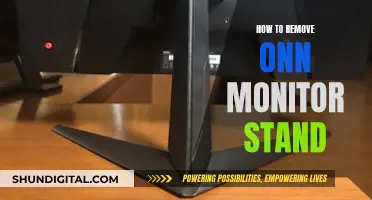
Ankle monitors are devices used to confine a person to a certain perimeter, and they can also be used to measure a person's alcohol levels. If you are caught driving under the influence, you may be given the choice of wearing an ankle monitor or going to jail. While wearing an ankle monitor, you must follow certain rules, such as keeping a job to pay the monthly maintenance fees, following a strict schedule, and staying off drugs and alcohol. If you wish to remove your ankle monitor early, you must present a valid argument to your probation officer and convince a judge that you no longer need it. However, attempting to remove or tamper with the ankle monitor without authorisation can have serious consequences, including an increase in probation or the loss of house arrest.
| Characteristics | Values |
|---|---|
| Legality | It is possible to remove an ankle monitor legally by submitting an official request to the court. |
| Request Format | The request must be in the form of a motion, which can be a written letter or a verbal speech. |
| Reasoning | It is important to have a legitimate reason for removing the ankle monitor, such as job-related requirements, medical attention, severe ankle pain, or mental stress. |
| Supervision Officer | Communicating with the supervision officer and maintaining a positive relationship can increase the chances of approval. |
| Motion Document | The motion document should include caption information, a title and body, case background, reasons for removal, a conclusion, and a certificate of service. |
| Order | An "Order" document with caption information and the order description must be composed and signed by the judge to grant the request. |
| Backups | Multiple backups of the motion document should be kept, including physical copies, for resubmission, court requests, and hearing preparation. |
| Hearing Date | Scheduling a hearing date before submitting the motion is necessary, and it can be done through a form or by creating a template with the required information. |
| Submission | The original motion document and copies should be submitted to the court, with potential filing fees. |
| Prosecutor and Supervision Officer | Sending a copy of the motion and hearing schedule to the prosecutor and supervision officer is respectful and increases the chances of approval. |
| Court Hearing | Arriving early, dressing appropriately, and bringing all required documents are important for a successful court hearing. |
| Argument | During the hearing, clearly and precisely state the argument, introducing yourself and following the points mentioned in the motion. |
What You'll Learn

Submit an official request to the court
To take off an ankle monitor, you must submit an official request, known as a motion, to the court. A motion is a request for a change of order or lawful decision. It can be proposed in a variety of forms, including a written letter or a verbal speech. There are several steps to submitting a motion to the court.
First, you must have a legitimate reason for removing your ankle monitor. Examples of legitimate reasons include job-related requirements or conflicts, travel requirements for your job, underwater jobs, medical attention, severe ankle pain or injury, mental stress and distraction, and more.
Second, communicate with your supervision officer. It is important to maintain a positive relationship with your supervision officer, as they will have input during your motion hearing. Explain why you want to remove your ankle monitor, and they may understand your concerns and support you during your motion hearing.
Third, create a motion document. This can be tricky, as there are specific rules, protocols, wordings, and sentence constructions that need to be followed. Consulting with an attorney is highly recommended to increase the chances of your motion being granted. The motion document should include caption information, such as the name of the court, the plaintiff or prosecutor, and the defendant. It should also include a title and body, introducing who you are representing and explaining that you want your ankle monitor removed.
Fourth, keep multiple backups of your motion document. It is important to have physical copies, not just a digital file, as the court may request multiple copies. Sending a copy to your supervision officer and prosecutor is also recommended.
Fifth, set up a hearing date. Each court handles the scheduling process differently, so it is best to ask the court staff or your attorney for guidance. Usually, a hearing schedule can be requested by submitting a form known as a Notice of Hearing.
Sixth, submit your motion to the court. Bring the original document and a few copies to the court. There may be a filing fee, and the court staff will review and approve your motion.
Seventh, send a copy of your motion to the prosecutor and the supervision officer. This step is optional but can increase the chances of your request being granted.
Eighth, attend the court hearing. It is important to arrive early, dress appropriately, and bring all required documents.
Ninth, state your argument during the hearing. Introduce yourself, explain who you are representing, and keep your argument clear and precise.
Finally, receive the decision from the judge. The judge will consider all aspects of the case and make a decision. If your motion is granted, you will be able to coordinate with your supervision officer to remove the ankle monitor. If your motion is denied, remain calm and respectful, as your behaviour can impact your entire case.
LG Monitor Buying Guide: Where to Buy?
You may want to see also

Have a legitimate reason for removal
To take off an ankle monitor legitimately, you must submit an official request to the court. The first step is to have a legitimate reason for its removal. For example, you might have a job that requires travel or demands underwater work, you need an MRI, CT-scan, or X-ray, or you are experiencing severe ankle pain or mental stress due to the monitor.
Once you have established a valid reason, you should communicate with your supervision officer, explaining your concerns and requesting their support. Even if they disagree, don't worry—it is ultimately the judge's decision. It is important to have complied with all court orders and to have a positive relationship with your supervision officer, as their recommendation will be considered by the judge.
Next, you will need to create a motion document. This is a request for the court to modify your conditions. Consult with your attorney to ensure your motion follows the correct format and includes all necessary information, such as the name of the court, plaintiff or prosecutor, and defendant. You will also need to provide a case background, explain your reasons for removal, and state that you have complied with all court orders. Include any supporting facts that will strengthen your argument, such as reliability in keeping work and paying court fees.
After composing your motion, make multiple physical copies and keep them handy. You will need to send a copy to your supervision officer and prosecutor, and the court may also request multiple copies. Having these documents prepared will ensure you are comfortable and confident when presenting your request.
Effective Ways to Remove Streaks and Smears from Your Monitor
You may want to see also

Consult a legal attorney
Consulting a legal attorney is highly recommended when seeking to remove an ankle monitor. They can provide essential insights and guidance throughout the process, increasing your chances of success. Here are some reasons why consulting a legal attorney is crucial:
Legal Expertise and Insights
Legal attorneys are experts in the field of law and can provide valuable insights into the legal system and its complexities. They understand the specific laws, regulations, and procedures related to ankle monitors and can guide you through the entire process. Their expertise will ensure that you follow the correct legal procedures and comply with the law at every step.
Assistance with Court Motions and Paperwork
The process of removing an ankle monitor often involves submitting a motion to the court. A motion is a request for a change in the court's order or decision. Your attorney can help you draft and submit this motion, ensuring that it adheres to the court's rules and protocols. They can advise you on the proper format, wording, and timing of your submission to maximise the chances of it being granted by the judge.
Representation in Court
If your case goes to a hearing, your legal attorney will be there to represent you and present your argument to the judge. They can help you prepare and guide you through the hearing process, ensuring that you effectively communicate your reasons for wanting the ankle monitor removed. Their presence can significantly improve your chances of a favourable outcome.
Knowledge of Legal Ramifications and Considerations
Ankle monitors are typically court-ordered, and tampering with or removing them without proper authorisation can result in severe legal consequences. A legal attorney can explain the specific legal ramifications and considerations involved in your case. They will ensure that you understand the potential repercussions and help you navigate the legal system to avoid any unintended consequences.
Guidance on Proper Removal Procedures
In addition to the legal aspects, attorneys can provide guidance on the proper removal procedures for ankle monitors. They can advise you on the necessary tools, precautions, and steps to take during the removal process. This includes information on deactivating the GPS tracking module and ensuring complete deactivation of the device.
Assistance with Authorisation and Documentation
Obtaining proper authorisation and documentation is crucial when removing an ankle monitor. Your attorney can help you navigate the legal channels to obtain the necessary permissions from the court or supervising agency. They will ensure that you have all the required documentation to support your request and provide proof of compliance with legal procedures.
In summary, consulting a legal attorney when seeking to remove an ankle monitor is of utmost importance. They can provide invaluable guidance, ensure compliance with the law, and increase your chances of a successful outcome. Their expertise and experience will help you navigate the complex legal system and make informed decisions throughout the process. Remember, removing an ankle monitor is a serious matter that requires proper authorisation and legal guidance.
Monitor Measurements: Pixels Wide, a Quick Guide
You may want to see also

Communicate with your supervision officer
Communicating with your supervision officer is an important step in the process of legally removing your ankle monitor. Here are some detailed instructions on how to effectively communicate with your supervision officer:
Understand Their Role:
Your supervision officer plays a crucial role in monitoring your compliance with the conditions of your probation, parole, or pre-trial release. They have the authority to report any violations to the court and can influence the outcome of your case. It is in your best interest to maintain a positive relationship with them.
Be Respectful and Maintain a Good Relationship:
Always be respectful and polite in your interactions with your supervision officer. Address them by their preferred title and name. Maintaining a positive and respectful relationship can have a favourable impact on the outcome of your request to remove the ankle monitor.
Explain Your Concerns:
Explain to your supervision officer why you want to remove the ankle monitor. Be honest and transparent about your concerns. For example, you may explain the physical discomfort, mental stress, or how it interferes with your job requirements. It is important that they understand your situation and may be more inclined to support your request.
Seek Their Support:
Ask your supervision officer if they would be willing to support your court request for removing the ankle monitor. They may have the discretion to approve minor adjustments, like resizing the belt or extending curfews, but for more significant changes, their recommendation to the judge can be influential.
Provide Relevant Information:
Keep your supervision officer informed about any developments in your case, especially if you need to remove the ankle monitor temporarily for medical examinations or other special occasions. Provide them with the necessary details and ask for their permission, following the proper procedures.
Ask for Clarifications and Assistance:
If you have questions or concerns about the conditions of your supervision, don't hesitate to ask your officer for clarifications. For instance, you can inquire about the frequency of charging the ankle monitor, permitted areas, or any other restrictions. They are there to provide guidance and ensure your compliance, so take advantage of their support.
Comply with Their Instructions:
It is crucial to follow the instructions and guidelines provided by your supervision officer. Comply with any requirements, such as meeting schedules, paying court fees, abstaining from restricted areas, and maintaining a drug and alcohol-free lifestyle. Demonstrating your commitment to following their instructions will reflect positively on your case.
Remember, while your supervision officer has the authority to make recommendations, the ultimate decision to remove the ankle monitor rests with the judge. Even if your officer decides not to approve your request, remain respectful and thank them for their time. You can still proceed with your motion request and make your case before the judge.
Monitoring Xbox Usage: Remote Control for Parents
You may want to see also

Create a motion document
How to Take Off an Ankle Monitor: Creating a Motion Document
This motion seeks to address the steps required to remove an ankle monitor, an electronic monitoring device typically used during house arrest or probation. It will outline the process, including any legal implications, and provide a detailed plan of action.
Ankle monitors, also known as electronic monitoring tags, are tracking devices worn by individuals under house arrest or probation. They are typically fitted with GPS technology, allowing authorities to track an individual's location at all times.
Reasons for Removal
There are several reasons why one may seek to remove an ankle monitor:
- Completion of House Arrest Sentence: If an individual has served their house arrest sentence, they may request the removal of the ankle monitor.
- Technical Issues: In some cases, the ankle monitor may malfunction or cause discomfort.
- Change in Custodial Status: If an individual's custodial status changes, such as being released on bail or granted parole, the ankle monitor may no longer be required.
Legal Considerations
Before creating a motion for the removal of an ankle monitor, it is essential to understand the legal implications.
Consult with Legal Professionals
It is advisable to consult with an attorney or legal advisor familiar with the specific laws and regulations regarding ankle monitors in your jurisdiction. They can provide guidance on the appropriate legal channels to ensure compliance with the law.
Understand the Conditions of Your Sentence or Probation
Review the terms and conditions of your sentence or probation to identify any specific requirements or restrictions regarding the removal of the ankle monitor. This information will be crucial in formulating your argument for removal.
Creating the Motion Document
The motion document should be structured as follows:
Begin by titling your motion clearly and concisely, such as "Motion for Removal of Ankle Monitor." In the introduction, identify yourself and your role in the case, whether you are the plaintiff or defendant, and state if you are represented by an attorney or acting pro se (representing yourself).
Request for Relief
Clearly state what action you want the court to take. For example, "I am requesting that this Court order the removal of the ankle monitor currently in place as a condition of my house arrest."
State Relevant Facts
Provide a detailed account of the facts relevant to your motion. For instance, you may state the duration of your house arrest, any compliance with the terms of your sentence, and the reason for your request.
Make Your Legal Argument
Present the legal basis for your request. Cite relevant laws, statutes, or case precedents that support your argument for the removal of the ankle monitor. You may also address any potential objections and explain how your request aligns with legal procedures.
Signature and Notary Block
Include a signature block where you affirm that the information provided is true and correct. Below this, add a notary block, which is a certification by a notary public confirming your signature. This step may vary depending on the requirements of your jurisdiction.
Certificate of Service
Add a "Certificate of Service," where you certify that you have notified all relevant parties of your motion. This ensures that everyone involved in the case is aware of your request.
Notice of Hearing
Include a "Notice of Hearing," which provides details about the scheduled hearing for your motion. This includes the date, time, and location of the hearing.
By following the outlined steps and considerations, you can effectively create a motion document for the removal of an ankle monitor. It is important to tailor your motion to your specific circumstances and seek legal advice where necessary to ensure compliance with the law.
CO2 Monitor Buying Guide: Where to Purchase
You may want to see also
Frequently asked questions
You can legally remove an ankle monitor by submitting an official request to the court.
The process involves the following steps:
- Have a legitimate reason for removing your ankle monitor, such as a job-related requirement, medical attention, or mental stress.
- Communicate your reason to your supervision officer and seek their support.
- Create a motion document, including all relevant information and arguments for removal. Consult an attorney for assistance.
- Keep multiple copies of your motion document and submit it to the court, along with any required fees.
- Set a hearing date and attend the court hearing, dressed appropriately and with all necessary documents.
There are alternative methods suggested online, but they are not recommended as they may be dangerous, illegal, or humorous trolling attempts. These methods include using tools like a hacksaw or chainsaw, causing an infection, or attaching the monitor to a dog.
Legitimate reasons for requesting the removal of an ankle monitor include:
- Conflicts with work clothing requirements or job demands that involve travelling or underwater work.
- Need for medical attention, hospitalization, or mental health issues caused by the monitor.
- Severe ankle pain or injury that warrants MRI, CT-scan, or X-ray.
Illegally removing an ankle monitor can result in legal repercussions, including arrest and further restrictions. It is important to follow the proper legal procedures to avoid such consequences.







